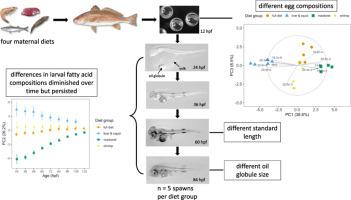Comparative Biochemistry and Physiology B: Biochemistry & Molecular Biology ( IF 1.9 ) Pub Date : 2021-06-24 , DOI: 10.1016/j.cbpb.2021.110639 Zhenxin Hou 1 , Lee A Fuiman 1

|
Embryonic and early larval development and metabolism of most teleost fishes are fueled entirely by maternally derived nutritional resources (yolk and oil) before the onset of exogenous feeding. The composition of those resources depends, in part, on maternal diet. To examine how diet-induced variations in egg composition affect embryonic and larval utilization of endogenous lipids and fatty acids, we fed red drum (Sciaenops ocellatus) broodstock four different diets to produce distinctive fatty acid compositions in eggs but with no significant difference in total lipid content. We sampled embryos and unfed larvae every 12 h from 12 h post-fertilization (hpf) until starvation (96–120 hpf; n = 5 spawns per diet group). Rates of utilization of the oil globule were significantly different among diet groups, resulting in significant differences in mean oil globule size at the first feeding stage (84 hpf). Utilization rates for 15 fatty acids were significantly different among diet groups and were proportional to their initial concentration. As a result, differences in larval fatty acid compositions among maternal diet groups diminished over time but remained different even at later stages. In addition, larval standard length at 84 hpf was positively correlated with egg total lipid content. This study suggests that the fatty acid composition of yolk and oil affects energy metabolism and tissue composition in red drum larvae. These effects could have consequences for the survival and essential physiological functions of fish larvae during the critical period of transition to exogenous feeding.
中文翻译:

母体饮食影响红鼓鱼胚胎和早期幼虫对内源性脂质的利用
大多数硬骨鱼的胚胎和早期幼虫发育和代谢完全由母体来源的营养资源(蛋黄和油)在外源喂养开始之前提供燃料。这些资源的构成部分取决于母亲的饮食。为了研究日粮引起的鸡蛋成分变化如何影响胚胎和幼虫对内源性脂质和脂肪酸的利用,我们给红鼓(Sciaenops ocellatus)亲鱼饲喂四种不同的饲料,以在鸡蛋中产生独特的脂肪酸成分,但总脂质没有显着差异。内容。我们从受精后 12 小时 (hpf) 到饥饿 (96–120 hpf; n = 每个饮食组 5 次产卵)。不同饮食组之间油球的利用率存在显着差异,导致第一饲喂阶段(84 hpf)的平均油球大小存在显着差异。15 种脂肪酸的利用率在饮食组之间有显着差异,并且与其初始浓度成正比。结果,母体饮食组之间幼虫脂肪酸组成的差异随着时间的推移而减少,但即使在后期仍保持不同。此外,84 hpf 的幼虫标准长度与鸡蛋总脂质含量呈正相关。这项研究表明蛋黄和油的脂肪酸组成影响红鼓幼虫的能量代谢和组织组成。







































 京公网安备 11010802027423号
京公网安备 11010802027423号